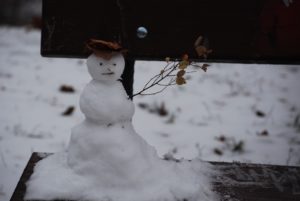Winter Fun for the Young Ones
With winter settling in, going outside feels like it takes more work. It is important to get outside our homes and get some fresh air and exercise. There are plenty of outdoor activities your family can do during the holiday break. Here are a few tips from the National Wildlife Federation (MUCC’s parent affiliate) on how to have some fun when hunting and fishing are not an option. Remember it is important to keep getting kids outside year-round.
With the cold weather, it is important to dress appropriately. This will help your family stay out longer and have a more enjoyable time outdoors. No one likes being cold. Make sure you bundle the kids up in the proper snow attire, with hats, gloves and boots.

Photo by Christophe Maertens on Unsplash
Scenario #1 : It is a chilly, gray day without a snowflake in sight. (current weather as I write this)
• Go for the gold: Create your own Wacky Winter Olympics, held in your yard or neighborhood park.
• Dog Sled Race: Competitors pull snow sleds loaded with toys, sticks, or rocks across the grass.
• Winter swim relay race: Give each child a tote bag of swim goggles, towel, an old adult swimsuit or oversized flippers. See how fast they can pull on the swim gear over their outdoor clothes, throw the towel around their neck, take a pretend “swim,” and run to a marker and back. Use a stopwatch to time which kid is the fastest.
• Award each participant with an “outdoorsy” Olympic medal—tie a pinecone to a string. Paint a rock into a trophy.
• Make ice sculptures: Fill a clear plastic container with a few inches of water. Add food coloring, stones, and sticks for decoration. Set outside for several hours or overnight to freeze. Add another layer of water and nature “stuff” dyed a different color and allow freezing. Repeat to create multiple layers.
• Take the earth’s temperature: You will need to make sure the ground isn’t frozen for this one. Buy a soil thermometer at a garden supply store and take it with you on a walk around the yard or park. Have your kids stick it in the ground in various locations to compare ground temperatures. Is the ground warmer or cooler than the air? Does the temperature change in different locations?
Scenario #2: It snowed, but not enough for sledding or building.
• Look for tracks. Light snowfall can reveal what animals are around looking for food.
• Go to the playground. You probably have not been there for a while, and kids may enjoy seeing their summer play place sprinkled with snow. Take pictures, so you can compare when spring arrives. Bring along a thermos of cider or hot chocolate.
• Zoom in on nature. Bring a magnifying glass outside to take a close-up look at the frozen leaves, twigs or ground.

PC: Kirill Sh on Unsplash
Scenario #3 : The snow has finally arrived in all its winter glory.
• Build a miniature luge track. Have the kids use metal spoons to carve parallel tracks in the snow. (Snow that frozen hard is best.) They can race the spoons, rubber balls, acorns, or anything else handy. Have the kids try different methods to create the fastest course.
• Make mini-snowmen out of snowballs. Younger children find making these little people easier than building the standard life-sized snowman. Older kids can spend more time on the details instead of building huge snow creatures. Challenge the kids to create a whole city of mini snow people.
• Think beyond snowmen. Expand snow building to include such things as cars, animals or favorite sports team logos. Use water with food coloring to “paint” creations.
• Go snowshoeing. Snowshoeing does not require fancy gear when you make your own out of cardboard cutouts, shoeboxes, folded newspapers, or tree branches. Attach to boots with string, rubber bands, or bungee cords and try a trek around your favorite green space.
There are plenty of opportunities to continue getting outside in the wintertime. What is your favorite winter activity to do with your family?
The post Winter Fun for the Young Ones appeared first on Michigan United Conservation Clubs.



